|
|
| Polychaetes
(Gr. polys, many, + chaite, long hair) are annelids. They
are the largest class of annelids. There are about 10,000 described
species, most of them being marine. Most polychaetes are about 5-10 cm
long, However, there are many that are smaller than a millimetre, and that
some can be as long as 3 metres. Some of them have very bright colour,
such as green or red. Others remain mostly dull in colour.
Habitats of Polychaetes
Polychaetes are mostly found under rocks, in coral
crevices or in abandoned shells. They can also burrow into mud or sand.
Some of them also build their own tubes in bottom material. Polychaetes
are abundant in some areas. For example, there can be thousands of
polychaetes in a square metre of mud flat.
The Structure of Polychaetes
Polychaetes have well-differentiated head and specialized
sensory organs and appendages on most segments called parapodia. There is no clitellum present in polychaetes. Also,
they have many forms of setae which are
arranged in bundles on the parapodia. |
|
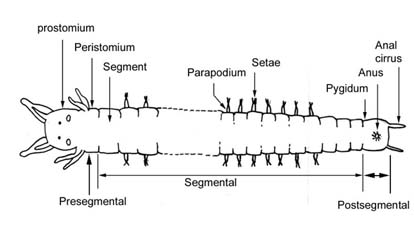
Fig 1. The general morphology
of polychaetes
(Adapted from Fauchald 1977) |
 | Prostomium |
The prostomium is
usually distinct and may have appendages. In some families, the prostomium
may fuse with the peristomium and
the first segment. However, it is difficult to determine the degree of
fusion, so that the taxonomic value of this character is low.
Prostomial appendages include antennae and palps.
Antennae are innervated through single roots directly from the brain.
Palps always have double roots either from the brain or from the
circumesophageal ring (Akesson 1963; Orrhage space 1966). Antennae are
sensory organ. Palps may be sensory in function or act as appendages which
are used for feeding. The position of palps also varies. They can be
ventral to dorsal position or from frontal to occipital. The position or
function of the palps is an important taxonomic character. |
|
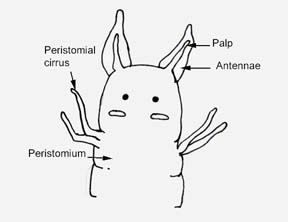
Fig 2. The general morphology
of prostomium
 
Lumbrineridae |
 | Peristomium |
The structure of peristomium
consists of larvally derived structure and one or more true segments. The
peristomium may carry a single pair of dorsal cirri called peristomial
cirri. The fused segment may carry parapodial remnants called tentacular cirri. In Hesionidae,
the number of tentacular cirri varies from one to four pairs. Other
families mostly have a constant number of tentacular cirri. |
|
|
 | Eversible pharynx |
Eversible pharynx is
part of the anterior digestive tract which everses from polychaetes. The
morphological features of the pharynx vary in different families.
There are jaws, teeth or other chitinized structures associated with the
anterior end of the pharynx. These features are useful characters in
classification of polychaetes.
In errantia families, the eversible buccal cavity forms a
proboscis which may be covered with papillae or made with hard chitinous
elements such as paragnaths and jaws. The proboscis is used for feeding
and burrowing.
In filter-feeding tubicolous polychaetes the buccal cavity is
not eversible and there is no proboscis. |
|
|
 | Parapodia |
The parapodia of polychaetes can be biramous or uniramous. Biramous parapodia refer to
the division of the foot into notopodia
and neuropodia. In uniramous
parapodia, polychaetes would only have neuropodia developed. The notopodia
are considered secondarily reduced (Fauchald 1974a). This is the main
morphological character to classify the families of polychaetes. The
detailed features of parapodia such as parapodial lobes or cirri are key characters to classify
polychaetes at the generic and species level. In addition, the presence or
absence of branchiae associated with
the parapodia is another feature on the parapodia. |
|
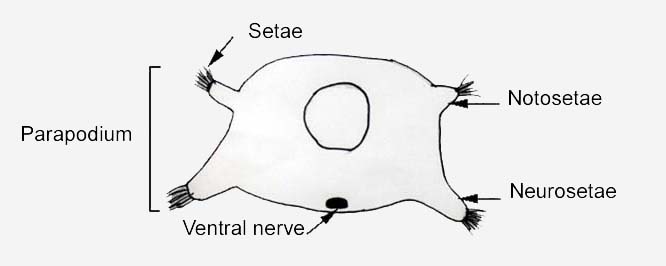
Fig 3. The general morphology
of parapodium
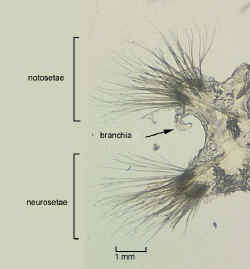
Biramous parapodium
(
Nephtyidae)
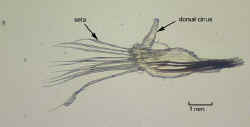
Uniramous parapodium
( Lumbrineridae) |
 | Setae |
There are numerous kinds of setae that can be found in
polychaetes, such as uncini, limbate
setae and acicular hooks. This is usually a family character for taxonomic
identification. For example, all members of Phyllodocidae have composite setae.
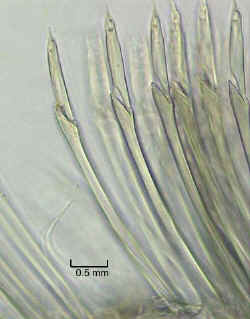 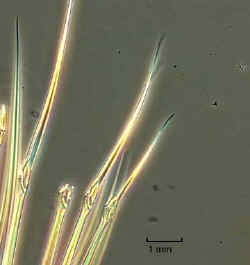
Acicular compound setae Compound setae
Compound setae
 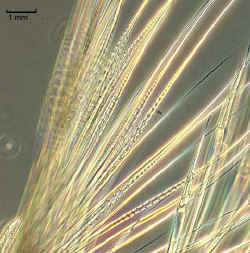
Capillary setae Bipennate neurosetae
Bipennate neurosetae
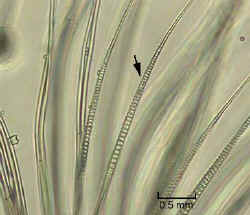 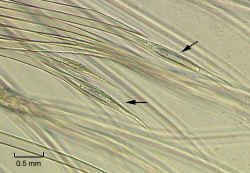
Denticulate setae Forked setae
Forked setae
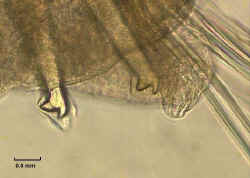 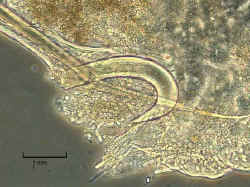
Acicular setae Hook setae
Hook setae |
|
Polychaetes are divided into two orders, ERRANTIA and SEDENTARIA. This
classification is based on the morphological features of the anterior end
of polychaetes and the living habit of the species.
ERRANTIA polychaetes have:
 |
Large number of body-segments. |
 |
Fewer number of anterior appendages which are
differentiated into palps, antennae or tentacular cirri, etc. |
 |
Mostly free-living with rapacious habit. |
 |
All polychaetes with jaws are considered in
this order. |
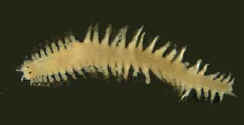
Errant polychaete
SEDENTARIA polychaetes have :
 |
Limited number of
body-segments. |
 |
Body may be separated into
different regions. |
 |
Anterior appendages may be
absent or similar appendages are present in a few to many in numbers. |
 |
Short parapodia associated
with tubicolous or burrowing habit. |
 |
Usually deposit or filter
feeders. |
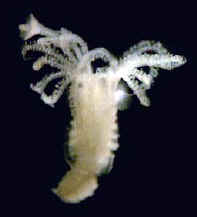
Sedentary polychaete
|
